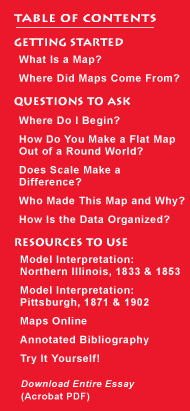talking history | syllabi | students | teachers | puzzle | about us
 |
Maps can be an important source of primary information for historic investigation. But what is a map? This is a deceptively simple question, until you're asked to provide an answer -- you may find it far more difficult than you think. Yet we encounter maps on a daily basis. The media uses them to pinpoint the location of the latest international crisis, many textbooks include them as illustrations, and we consult maps to help us navigate from place to place. Maps are so commonplace; we tend to take them for granted. Yet sometimes the familiar is far more complex than it appears. "What is a map?" has more than one answer. Norman Thrower, an authority on the history of cartography, defines a map as, "A representation, usually on a plane surface, of all or part of the earth or some other body showing a group of features in terms of their relative size and position."* This seemingly straightforward statement represents a conventional view of maps. From this perspective, maps can be seen as mirrors of reality. To the student of history, the idea of a map as a mirror image makes maps appear to be ideal tools for understanding the reality of places at different points in time. However, there are a few caveats concerning this view of maps. True, a map is an image of a place at a particular point in time, but that place has been intentionally reduced in size, and its contents have been selectively distilled to focus on one or two particular items. The results of this reduction and distillation are then encoded into a symbolic representation of the place. Finally, this encoded, symbolic image of a place has to be decoded and understood by a map reader who may live in a different time period and culture. Along the way from reality to reader, maps may lose some or all of their reflective capacity or the image may become blurred. So what is a map? A map is text. John Pickles, a geographer with interests in social power and maps, suggests:
In this view, maps are a form of symbolization, governed by a set of conventions, that aim to communicate a sense of place. To fully understand a map we need to know how to decode its message and place it within its proper spatial, chronological, and cultural contexts. Maps, even modern maps, are historic. They represent a particular place at a particular point in time. This definition of a map (although, like the mirror image idea, is also problematic) suggests that maps can afford the viewer a great opportunity to gain insights into the nature of places. Why do relatively few scholars outside of geography use maps and why do maps intimidate people? Michael Peterson, a cartographer and professor of Geography at the University of Nebraska, Omaha, raises a critical issue that may also help to explain why maps are not utilized. He asserts that even highly educated people have trouble using maps and that more than half lack "basic" map competency. Peterson concludes that, "Most people are essentially map illiterate." (See Michael P. Peterson's article, "Cartography and the Internet: Implications for Modern Cartography"). My own experience teaching geography courses for more than thirty years substantiates Peterson's assertions. Students often lack the basic skills necessary to read maps, much less the analytical skills needed to grasp the insights that maps can afford. This guide aims to help provide those basic skills.
|
|||
 |
||||

